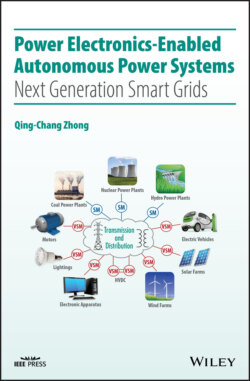Читать книгу Power Electronics-Enabled Autonomous Power Systems - Qing-Chang Zhong - Страница 38
2.6.2 The Second‐Generation (2G) VSM
ОглавлениеIt is well known that synchronous machines have inductive output impedances because of the stator windings. However, the output impedance of power electronic converters changes with the hardware design and the controller and could be inductive (denoted L‐converters), resistive (denoted R‐converters) (Guerrero et al. 2005; Zhong 2013c), capacitive (denoted C‐converters) (Zhong and Zeng 2011, 2014), resistive‐inductive (denoted ‐converters), resistive‐capacitive (denoted ‐converters) or complex around the fundamental frequency. The impedance of converters plays an important role in system stability (Sun 2011; Vesti et al. 2013; Wang et al. 2015b; Zhong and Zhang 2019). For inverters with different types of output impedance, the widely adopted droop control appears in different forms (Zhong and Hornik 2013), which means converters with different types of impedance connected together could lead to instability. The droop controller adopted in synchronverters and conventional power systems implicitly assumes that the impedance is dominantly inductive. There is a need to develop a SYNDEM technical route that is applicable to converters with different types of impedance, while possessing the synchronization mechanism of synchronous machines.
Since a droop controller structurally resembles an enhanced PLL (Zhong and Boroyevich 2013, 2016), it also has the intrinsic synchronization mechanism of synchronous machines and can provide a potential technical route to implement VSMs. The robust droop controller (Zhong 2013c), initially proposed for R‐inverters to achieve accurate power sharing and tight voltage regulation, has been proven to be universal and applicable to inverters with output impedance having an impedance angle between rad and rad (Zhong and Zeng 2016). Moreover, it can be equipped with a self‐synchronization mechanism without a PLL (Zhong et al. 2016). Hence, the robust droop controller offers another, actually better, technical route to implement SYNDEM smart grids. A VSM based on the robust droop controller is classified as a second‐generation (2G) VSM.
